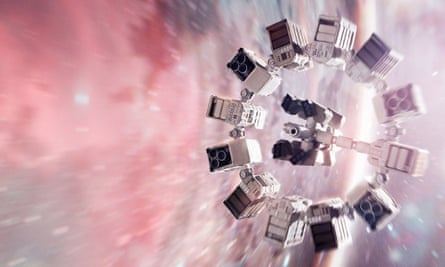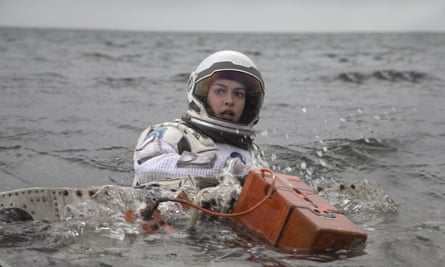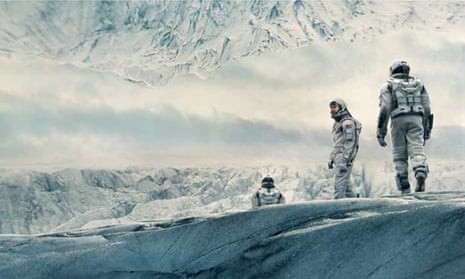Perhaps it’s the hype, but I was expecting more science in Interstellar, as opposed to science fiction. I was a little disappointed, I must admit, that the core science of the movie, the plot devices that made the movie work, seemed to be a little fragile in terms of physics and the science that goes through them. There was much that was accurate: the representations of space travel, zero gravity, the surfaces of other planets – they were all fantastic. Alongside this, though, were many classical devices of science fiction: time travel, warping of space-time, travelling vast distances in extremely short time. Interstellar had a veneer of science, but at its core was not as sound as I thought it might be.

Space travel
The main vehicle, Endurance, was well conceived. The idea of it spinning around to generate gravity for the long journey, that’s fine. The position of its windows in relation to the rotation of light patterns; that was really well done. The one thing I would criticise: you don’t see any fuel tanks. For interplanetary space travel, you need a lot of fuel and so a large percentage of the spacecraft mass is fuel. You can’t imagine what sort of propulsion Endurance is using. It becomes obvious when they reach Saturn: how do they slow down? You need a big rocket in the front of your spacecraft, the same size as the one you used to accelerate up to speed to begin with. It’s as simple as that – otherwise you will just miss the planet and fly past. The little retro rockets we see in the film are much too small.
Added to which, two years for a journey to Saturn seems on the short side to me. If you use the most fuel-efficient way of getting there, it would take about 4.7 years, and would only work in certain time windows when the planets are aligned correctly. The New Horizons spaceship did get there in two years and four months, but that’s because it was on its way to Pluto and did not slow down at Saturn. If you want to stop there, it would take much longer because you have to brake to get into orbit.
Mathematics
There’s a nice veneer of mathematics in the film – for example, the equations on the board are textbook general relativity equations, which is nice for a science geek. Later on, the script suggests the equations don’t work because scientists don’t understand how gravity and quantum mechanics work together, and that’s fair enough. But the film resolves this by sending a robot down into a black hole to send back “quantum data” - that doesn’t really make any sense. It sounds like something they just made up as a plot device with no physics behind it.

Wormhole
In terms of its visual representation, the wormhole has been thought through. The crew discover a kind of sphere, with a distorted pattern of light, which is plausible. When you have this strong concentration of mass, you have distortion of distant objects - this is akin to what you would imagine this might look like.
Relativity
One of the big plot devices revolves around the first planet they visit, the water planet: one hour on its surface corresponds to seven years on earth. Scienticifically, this is fine; it’s well known that time flows more slowly in the presence of a gravitational field – but the question is: is this extreme time dilation plausible on a planet like the one they land on? At one point, we are told that the gravity on this planet is 130% of that of Earth’s – and we see the actors panting, a little bit under duress because of the extra gravity. But is it enough for this time dilation? Not even close. If you visited the surface of our sun, which is not a supermassive body but still much more massive than Earth, you would gain about 66 seconds per year. To get to an extreme dilation, where one hour corresponds to seven years, you would need such a strong gravitational field that you need to be close to what is called the Schwarzschild radius of the object – essentially the event horizon of a black hole. There is simply no planet that can have this kind of gravity and if you tried to land on the surface, it would be so strong it would crush you. The numbers simply do not work.

Black holes
They encounter a planet near a black hole, and decide to go around it to avoid the “time shift zone” - they talk about time shift as if it has a distinct boundary but it just doesn’t work like that - it’s gradual, progressive, and is the same in all directions. Also, if there’s such a strong gravitational field, then the planet itself would be destroyed by the difference in gravity between its opposite sides. Finding a stable planet within such a strong gravitational field is a stretch of the imagination. It just wouldn’t happen.
The visual presentation of the black hole – a big disc of luminous matter rotating around it being eaten up by the gravitational pull - is certainly plausible. But if you were to find yourself in this region, you are as likely to die from the radiation from the disc, which is very hot and emitting gamma rays, as much as from the gravitational pull. When you are close to a black hole, the gravity at your feet will be much stronger than the gravty at your head, so you get spaghettified, stretched out, like a piece of spaghetti, into a filament of matter. We see no evidence of that happening.
Conclusion
We don’t really know what interstellar travel looks like, so all bets are off. If you compare Interstellar to Gravity, it is a much harder film to make. We know what it is like to be in earth orbit, the mechanics are pretty simple, so Gravity could get the physics right with the correct advice. Interstellar wants to examine bigger issues, much of the science is unknown and if you stretch it beyond plausibility - as you always do in a movie like this, you are bound to end up with things not supported by current scientific knowledge. It’s just a hard job!
Dr Roberto Trotta (@R_Trotta) is senior lecturer in astrophysics at Imperial College London. The Edge of the Sky: All You Need to Know About the All-There-Is by Roberto Trotta (Basic Books) is out now.









Comments (…)
Sign in or create your Guardian account to join the discussion